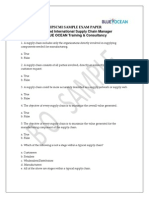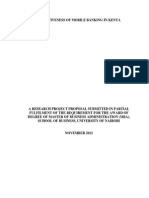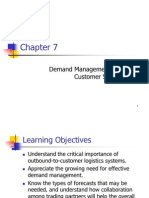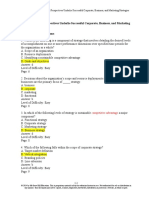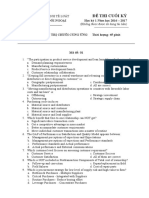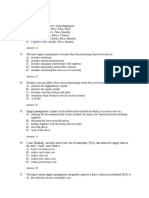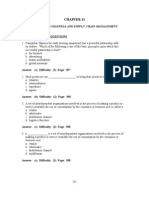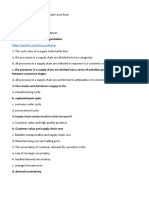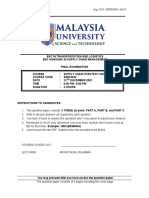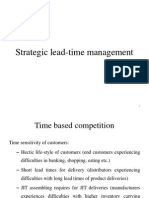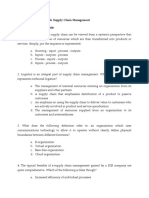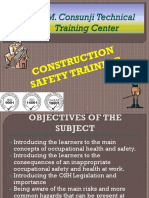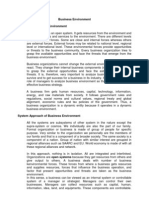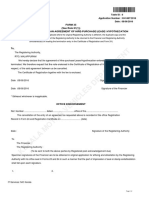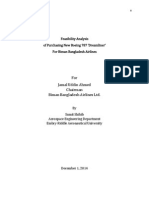Chapter 2 Suply Chain Management
Chapter 2 Suply Chain Management
Uploaded by
lasireCopyright:
Available Formats
Chapter 2 Suply Chain Management
Chapter 2 Suply Chain Management
Uploaded by
lasireOriginal Description:
Copyright
Available Formats
Share this document
Did you find this document useful?
Is this content inappropriate?
Copyright:
Available Formats
Chapter 2 Suply Chain Management
Chapter 2 Suply Chain Management
Uploaded by
lasireCopyright:
Available Formats
Chapter 2 Supply Chain Performance: Achieving Strategic Fit and Scope
True/False 1. A companys competitive strategy defines the set of customer needs that it seeks to satisfy through its products and services. Answer: True Difficulty: Easy
2. The value chain emphasizes the close relationship between all the functional strategies within a company. Answer: True Difficulty: Moderate 3. A companys product development strategy defines the set of customer needs that it seeks to satisfy through its products and services. Answer: False Difficulty: Moderate 4. A companys product development strategy specifies the portfolio of new products that it will try to develop. Answer: True Difficulty: Easy 5. A companys supply chain strategy specifies how the market will be segmented and how the product will be positioned, priced, and promoted. Answer: False Difficulty: Easy 6. A companys supply chain strategy determines the nature of procurement and transportation of materials as well as the manufacture and distribution of the product. Answer: True Difficulty: Easy 7. The degree of supply chain responsiveness should be consistent with the implied uncertainty. Answer: True Difficulty: Easy 8. The degree of supply chain responsiveness does not need to be consistent with the implied uncertainty. Answer: False Difficulty: Moderate 9. To achieve complete strategic fit, a firm must ensure that all functions in the value chain have consistent strategies that support the competitive strategy. Answer: True Difficulty: Moderate
10. To achieve complete strategic fit, a firm must ensure that all functions in the value chain have diverse strategies that support functional goals. Answer: False Difficulty: Moderate 11. Because demand and supply characteristics change, the supply chain strategy must change over the product life cycle if a company is to continue achieving strategic fit. Answer: True Difficulty: Easy 12. The supply chain strategy must be established at the beginning of the product life cycle and not changed if a company is to continue achieving strategic fit. Answer: False Difficulty: Easy 13. To retain strategic fit, supply chain strategy must be adjusted over the life cycle of a product and as the competitive landscape changes. Answer: True Difficulty: Moderate 14. The intercompany scope of strategic fit is essential today because the competitive playing field has shifted from company versus company to supply chain versus supply chain. Answer: True Difficulty: Moderate 15. The intercompany scope of strategic fit is no longer relevant today because the competitive playing field has shifted from company versus company to supply chain versus supply chain. Answer: False Difficulty: Easy 16. The intercompany scope of strategic fit requires firms to evaluate every action in the context of the entire supply chain. Answer: True Difficulty: Moderate 17. There is a close connection between the design and management of supply chain flows and the success of a supply chain. Answer: True Difficulty: Easy
Multiple Choice 1. A companys competitive strategy a. defines the set of customer needs that it seeks to satisfy through its products and services. b. specifies the portfolio of new products that it will try to develop. c. specifies how the market will be segmented and how the product will be positioned, priced, and promoted.
d.
determines the nature of procurement and transportation of materials as well as manufacture and distribution of the product. e. determines how it will obtain and maintain the appropriate set of skills and abilities to meet customer needs. Answer: a Difficulty: Moderate 2. A companys product development strategy a. defines the set of customer needs that it seeks to satisfy through its products and services. b. specifies the portfolio of new products that it will try to develop. c. specifies how the market will be segmented and how the product will be positioned, priced, and promoted. d. determines the nature of procurement and transportation of materials as well as manufacture and distribution of the product. e. determines how it will obtain and maintain the appropriate set of skills and abilities to meet customer needs. Answer: b Difficulty: Easy
3. A companys marketing and sales strategy a. defines the set of customer needs that it seeks to satisfy through its products and services. b. specifies the portfolio of new products that it will try to develop. c. specifies how the market will be segmented and how the product will be positioned, priced, and promoted. d. determines the nature of procurement and transportation of materials as well as manufacture and distribution of the product. e. determines how it will obtain and maintain the appropriate set of skills and abilities to meet customer needs. Answer: c Difficulty: Moderate 4. A companys supply chain strategy a. defines the set of customer needs that it seeks to satisfy through its products and services. b. specifies the portfolio of new products that it will try to develop. c. specifies how the market will be segmented and how the product will be positioned, priced, and promoted. d. determines the nature of procurement and transportation of materials as well as manufacture and distribution of the product. e. determines how it will obtain and maintain the appropriate set of skills and abilities to meet customer needs. Answer: d Difficulty: Easy 5. Which of the following determines the nature of procurement of raw materials, transportation of materials to and from the company, manufacture of the product or operation to provide the service, and distribution of the product to the customer along with follow-up service? a. Competitive strategy
b. Product development strategy c. Marketing and sales strategy d. Supply chain strategy e. none of the above Answer: d Difficulty: Easy 6. Which of the following defines the set of customer needs that a company seeks to satisfy through its products and services? a. Competitive strategy b. Product development strategy c. Marketing and sales strategy d. Supply chain strategy e. none of the above Answer: a Difficulty: Moderate 7. Which of the following specifies how the market will be segmented and how the product will be positioned, priced, and promoted? a. Competitive strategy b. Product development strategy c. Marketing and sales strategy d. Supply chain strategy e. none of the above Answer: c Difficulty: Moderate 8. Which of the following specifies the portfolio of new products that a company will try to develop? a. Competitive strategy b. Product development strategy c. Marketing and sales strategy d. Supply chain strategy e. all of the above Answer: b Difficulty: Easy 9. A supply chain strategy includes a. supplier strategy. b. operations strategy. c. logistics strategy. d. all of the above e. none of the above Answer: d Difficulty: Moderate 10. A supply chain strategy involves decisions regarding a. inventory. b. transportation. c. operating facilities. d. information flows.
e. all of the above Answer: e Difficulty: Moderate 11. A supply chain strategy involves decisions regarding all of the following except a. inventory. b. transportation. c. new product development. d. operating facilities. e. information flows. Answer: c Difficulty: Moderate 12. Which of the following is a key to the success or failure of a company? a. The competitive strategy and all functional strategies must fit together to form a coordinated overall strategy. b. Each functional strategy must support other functional strategies and help a firm reach its competitive strategy goal. c. The different functions in a company must appropriately structure their processes and resources to be able to execute strategies successfully. d. All of the above are keys to success. e. None of the above are a key to success. Answer: d Difficulty: Moderate 13. Which of the following is not a key to the success or failure of a company? a. The competitive strategy and all functional strategies must fit together to form a coordinated overall strategy. b. Each functional strategy must support other functional strategies and help a firm reach its competitive strategy goal. c. The different functions in a company must appropriately structure their processes and resources to be able to execute strategies successfully. d. All of the above are keys to success. e. None of the above are a key to success. Answer: d Difficulty: Moderate 14. Which of the following is not a key to the success or failure of a company? a. The competitive strategy and all functional strategies must fit together to form a coordinated overall strategy. b. The competitive strategy and all functional strategies operate independently of each other. c. The different functions in a company must appropriately structure their processes and resources to be able to execute strategies successfully. d. Each functional strategy must support other functional strategies and help a firm reach its competitive strategy goal. e. All of the above are keys to success. Answer: b Difficulty: Moderate 15. Which of the following are basic steps to achieving strategic fit?
a. Understanding the customer and supply uncertainty. b. Understanding the supply chain capabilities. c. Achieving strategic fit. d. All of the above are basic steps to achieving strategic fit. e. None of the above are a basic step to achieving strategic fit. Answer: d Difficulty: Moderate 16. Customer demand from different segments varies along which of the following attributes? a. The quantity of product needed in each lot. b. The response time that customers are willing to tolerate. c. The variety of products needed. d. The service level required. e. all of the above Answer: e Difficulty: Easy 17. The uncertainty of customer demand for a product is the a. rate of strategic uncertainty. b. demand uncertainty. c. implied demand uncertainty. d. average forecast error. e. none of the above Answer: b Difficulty: Moderate 18. The uncertainty that exists due to the portion of demand that the supply chain is required to meet is the a. rate of strategic uncertainty. b. demand uncertainty. c. implied demand uncertainty. d. average forecast error. e. none of the above Answer: c Difficulty: Moderate 19. Which of the following customer needs will cause implied uncertainty of demand to increase? a. Range of quantity required increases b. Lead time decreases c. Variety of products required increases d. Required service level increases e. all of the above Answer: e Difficulty: Easy 20. Which of the following customer needs will cause implied uncertainty of demand to decrease? a. Range of quantity required increases b. Lead time decreases
c. Variety of products required increases d. Required service level increases e. none of the above Answer: e Difficulty: Moderate 21. Which of the following customer needs will cause implied uncertainty of demand to increase? a. Product margin b. Lead time decreases c. Average stockout rate d. Average forced season end markdown e. none of the above Answer: b Difficulty: Moderate 22. Which of the following characteristics of customer demand have a correlation with implied uncertainty? a. Product margin b. Average forecast error c. Average stockout rate d. Average forced season end markdown e. all of the above Answer: e Difficulty: Moderate 23. Which of the following is not a characteristic of customer demand correlated with implied uncertainty? a. Product margin b. Unpredictable and low yields c. Average stockout rate d. Average forced season end markdown e. None of the above are correlated with implied uncertainty Answer: b Difficulty: Moderate 24. Which of the following supply chain capabilities will cause supply uncertainty to increase? a. Frequent breakdowns b. Unpredictable and low yields c. Poor quality d. Limited supply capacity e. all of the above Answer: e Difficulty: Easy 25. Which of the following supply chain capabilities will cause supply uncertainty to increase? a. Evolving production process b. Inflexible supply capacity c. Limited supply capacity
d. Unpredictable and low yields e. all of the above Answer: e Difficulty: Easy 26. Which of the following supply chain capabilities will cause supply uncertainty to decrease? a. Evolving production process b. Inflexible supply capacity c. Limited supply capacity d. Unpredictable and low yields e. none of the above Answer: e Difficulty: Moderate 27. Which of the following is not a supply chain capability that will impact supply uncertainty? a. Evolving production process b. Inflexible supply capacity c. Limited supply capacity d. Product margin e. Unpredictable and low yields Answer: d Difficulty: Moderate 28. The first step in achieving strategic fit between competitive and supply chain strategies is to a. understand the supply chain and map it on the responsiveness spectrum. b. understand customers and supply chain uncertainty. c. match supply chain responsiveness with the implied uncertainty of demand. d. ensure that all functional strategies within the supply chain support the supply chains level of responsiveness. e. none of the above Answer: b Difficulty: Hard 29. The second step in achieving strategic fit between competitive and supply chain strategies is to a. understand the supply chain and map it on the responsiveness spectrum. b. understand customers and supply chain uncertainty. c. match supply chain responsiveness with the implied uncertainty of demand. d. ensure that all functional strategies within the supply chain support the supply chains level of responsiveness. e. none of the above Answer: a Difficulty: Hard 30. The final step in achieving strategic fit between competitive and supply chain strategies is to a. understand the supply chain and map it on the responsiveness spectrum.
b. understand customers and supply chain uncertainty. c. match supply chain responsiveness with the implied uncertainty of demand. d. combine customer and supply chain uncertainty and map it on the implied uncertainty spectrum. e. all of the above Answer: c Difficulty: Moderate 31. Supply chain responsiveness includes the ability to do which of the following? a. Respond to wide ranges of quantities demanded b. Meet short lead times c. Handle a large variety of products d. Meet a very high service level e. all of the above Answer: e Difficulty: Easy 32. Supply chain responsiveness includes the ability to do which of the following? a. Handle supply uncertainty b. Build highly innovative products c. Meet short lead times d. Meet a very high service level e. all of the above Answer: e Difficulty: Easy 33. Supply chain responsiveness includes the ability to do which of the following? a. Handle supply uncertainty b. Understand customers and supply chain uncertainty c. Match supply chain responsiveness with the implied uncertainty of demand d. Ensure that all functional strategies within the supply chain support the supply chains level of responsiveness e. none of the above Answer: a Difficulty: Moderate 34. Supply chain responsiveness includes the ability to do which of the following? a. Understand customers and supply chain b. Meet a very high service level c. Match supply chain responsiveness with the implied uncertainty of demand d. Ensure that all functional strategies within the supply chain support the supply chains level of responsiveness e. none of the above Answer: b Difficulty: Moderate 35. Supply chain responsiveness includes the ability to do which of the following? a. Understand customers and supply chain b. Match supply chain responsiveness with the implied uncertainty of demand c. Meet short lead times
d. Ensure that all functional strategies within the supply chain support the supply chains level of responsiveness e. all of the above Answer: c Difficulty: Moderate 36. The cost of making and delivering a product to the customer is referred to as a. supply chain responsiveness. b. supply chain efficiency. c. cost-responsiveness efficient frontier. d. implied uncertainty. e. none of the above Answer: b Difficulty: Easy 37. The curve that shows the lowest possible cost for a given level of responsiveness is referred to as the a. supply chain responsiveness curve. b. supply chain efficiency curve. c. cost-responsiveness efficient frontier. d. responsiveness spectrum. e. none of the above Answer: c Difficulty: Moderate 38. A firm that is not on the cost-responsiveness efficient frontier can improve a. both responsiveness and cost performance. b. only responsiveness. c. only cost performance. d. responsiveness, but not cost performance. e. neither responsiveness nor cost performance. Answer: a Difficulty: Easy 39. A firm that is on the cost-responsiveness efficient frontier can improve a. responsiveness only by increasing cost and becoming less efficient. b. cost performance only by reducing responsiveness. c. both responsiveness and cost performance by improving processes and changing technology to shift the efficient frontier. d. all of the above e. neither responsiveness nor cost performance. Answer: d Difficulty: Moderate 40. A graph with two axes with implied uncertainty along the horizontal axis and responsiveness along the vertical axis is referred to as the a. implied uncertainty spectrum. b. responsiveness spectrum. c. uncertainty/responsiveness map. d. zone of strategic fit. e. none of the above
Answer: c Difficulty: Moderate 41. The relationship where increasing implied uncertainty from customers and supply sources is best served by increasing responsiveness from the supply chain is known as the a. implied uncertainty spectrum. b. responsiveness spectrum. c. uncertainty/responsiveness map. d. zone of strategic fit. e. none of the above Answer: d Difficulty: Moderate 42. To achieve complete strategic fit, a firm must a. consider all functional strategies within the value chain. b. ensure that all functions in the value chain have consistent strategies that support the competitive strategy. c. ensure that all substrategies within the supply chain such as manufacturing, inventory, and purchasing be consistent with the supply chains level of responsiveness. d. all of the above e. none of the above Answer: d Difficulty: Hard 43. The drive for strategic fit should come from a. the supply chain manager. b. the strategic planning department. c. the highest levels of the organization, such as the CEO. d. middle management. e. sales and marketing. Answer: c Difficulty: Hard 44. The important points to remember about achieving strategic fit are a. there is one best supply chain strategy for all competitive strategies. b. there is no right supply chain strategy independent of the competitive strategy. c. there is a right supply chain strategy for a given competitive strategy. d. all of the above e. b and c only Answer: e Difficulty: Hard 45. The preferable supply chain strategy for a firm that sells multiple products and serves customer segments with very different needs is to a. set up independent supply chains for each different product or customer segment. b. set up a supply chain that meets the needs of the highest volume product or customer segment.
tailor the supply chain to best meet the needs of each products demand. set up a supply chain that meets the needs of the customer segment with the highest implied uncertainty. e. set up a supply chain that meets the needs of product with the highest implied uncertainty. Answer: c Difficulty: Hard c. d. 46. Which of the following would not be a demand and supply characteristic toward the beginning stages of a products life cycle? a. Demand is very uncertain and supply may be unpredictable. b. Demand has become more certain and supply is predictable. c. Margins are often high and time is crucial to gaining sales. d. Product availability is crucial to capturing the market. e. Cost is often of secondary consideration. Answer: b Difficulty: Moderate 47. Which of the following would be a demand and supply characteristic toward the beginning stages of a products life cycle? a. Demand has become more certain and supply is predictable. b. Margins are lower due to an increase in competitive pressure. c. Product availability is crucial to capturing the market. d. Price becomes a significant factor in customer choice. e. none of the above Answer: c Difficulty: Moderate 48. Which of the following would not be a demand and supply characteristic in the later stages of a products life cycle? a. Demand has become more certain and supply is predictable. b. Margins are lower due to an increase in competitive pressure. c. Product availability is crucial to capturing the market. d. Price becomes a significant factor in customer choice. e. All of the above are characteristics of the later stages. Answer: c Difficulty: Moderate 49. The functions and stages that devise an integrated strategy with a shared objective are referred to as a. competitive strategy. b. supply chain strategy. c. scope of strategic fit. d. scope of marketing strategy. e. scope of product development strategy. Answer: c Difficulty: Moderate 50. The most limited scope over which strategic fit is considered is one operation within a functional area in a company. This is referred to as a. intracompany intraoperational scope.
b. intracompany intrafunctional scope. c. intracompany interoperational scope. d. intercompany interfunctional scope. e. agile intercompany scope. Answer: a Difficulty: Easy 51. The scope of strategic fit that includes all operations within a function in a company is a. intracompany intraoperational scope. b. intracompany intrafunctional scope. c. intracompany interoperational scope. d. intercompany interfunctional scope. e. agile intercompany scope. Answer: b Difficulty: Easy 52. The scope of strategic fit where all functional strategies are developed to support both each other and the competitive strategy in order to maximize company profit is a. intracompany intraoperational scope. b. intracompany intrafunctional scope. c. intracompany interoperational scope. d. intercompany interfunctional scope. e. agile intercompany scope. Answer: c Difficulty: Easy 53. The scope of strategic fit that requires that each company evaluate its actions in the context of the entire supply chain is a. intracompany intraoperational scope. b. intracompany intrafunctional scope. c. intracompany interoperational scope. d. intercompany interfunctional scope. e. agile intercompany scope. Answer: d Difficulty: Easy 54. A firms ability to achieve strategic fit when partnering with supply chain stages that change over time is referred to as a. intracompany intraoperational scope. b. intracompany intrafunctional scope. c. intracompany interoperational scope. d. intercompany interfunctional scope. e. agile intercompany scope. Answer: e Difficulty: Easy Essay/Problems
1.
Discuss the two keys to the success or failure of a company.
Answer: A companys success or failure is thus closely linked to the following keys: 1. The competitive strategy and all functional strategies must fit together to form a coordinated overall strategy. Each functional strategy must support other functional strategies and help a firm reach its competitive strategy goal. 2. The different functions in a company must appropriately structure their processes and resources to be able to execute these strategies successfully. Difficulty: Hard 2. List and explain the three basic steps to achieving strategic fit. Answer: There are three basic steps to achieving strategic fit: 1. Understanding the customer and supply chain uncertainty. First a company must understand the customer needs for each targeted segment and the uncertainty the supply chain faces in satisfying these needs. These needs help the company define the desired cost and service requirements. The supply chain uncertainty helps the company identify the extent of disruption and delay the supply chain must be prepared for. 2. Understanding the supply chain capabilities. There are many types of supply chains, each of which is designed to perform different tasks well. A company must understand what its supply chain is designed to do well. 3. Achieving strategic fit. If a mismatch exists between what the supply chain does particularly well and the desired customer needs, the company will either need to restructure the supply chain to support the competitive strategy or alter its strategy. Difficulty: Moderate 3. List the attributes along which customer demand from different segments can vary. Answer: In general, customer demand from different segments may vary along several attributes as follows: The quantity of the product needed in each lot The response time that customers are willing to tolerate The variety of products needed The service level required The price of the product The desired rate of innovation in the product Difficulty: Moderate 4. List the abilities included in supply chain responsiveness. Answer: Supply chain responsiveness includes a supply chains ability to do the following: Respond to wide ranges of quantities demanded Meet short lead times Handle a large variety of products Build highly innovative products Meet a very high service level
Handle supply uncertainty Difficulty: Moderate 5. Discuss the impact of the product life cycle on strategic fit between implied demand uncertainty and supply chain responsiveness. Answer: As products go through their life cycle, the demand characteristics and the needs of the customer segments being served change. Supply characteristics also change as the product and production technologies mature. High-tech products are particularly prone to these life cycle swings over a very compressed time span. A product goes through life cycle phases from the introductory phase, when only the leading edge of customers is interested in it and supply is uncertain, all the way to the point at which the product becomes a commodity, the market is saturated, and supply is predictable. Thus, if a company is to maintain strategic fit, its supply chain strategy must evolve as its products enter different phases. As products mature, the corresponding supply chain strategy should, in general, move from being responsive to being efficient. The key point here is that demand and supply characteristics change over a products life cycle. Because demand and supply characteristics change, the supply chain strategy must also change over the product life cycle if a company is to continue achieving strategic fit. Difficulty: Moderate 6. Explain scope of strategic fit. Answer: Scope of strategic fit refers to the functions and stages that devise an integrated strategy with a shared objective. It is a key issue relating to strategic fit in terms of supply chain stages, across which the strategic fit applies. At one extreme, every operation within each functional area devises its own independent strategy with the objective of optimizing its individual performance. In this case, the scope of strategic fit is restricted to an operation in a functional area within a stage of the supply chain. At the opposite extreme, all functional areas within all stages of the supply chain devise strategy jointly with a common objective of maximizing supply chain profit. In this case, the scope of strategic fit extends to the entire supply chain. Expanding the scope of strategic fit improves supply chain performance. The scope of strategic fit can be represented on a two-dimensional grid. Horizontally, the scope of strategic fit is considered across different supply chain stages, starting from suppliers and moving all the way along the chain to the customer. Vertically, the scope is applied to the fit achieved across different functional strategies, competitive, product development, supply chain, and marketing.
You might also like
- Ipscmi Sample Exam Paper Certified International Supply Chain Manager BLUE OCEAN Training & ConsultancyDocument5 pagesIpscmi Sample Exam Paper Certified International Supply Chain Manager BLUE OCEAN Training & ConsultancyYasith Weerasinghe100% (1)
- Supply Chain Analytics - Solved Quiz (REFER THIS PDF FOR FINAL EXAM ANSWERS)Document19 pagesSupply Chain Analytics - Solved Quiz (REFER THIS PDF FOR FINAL EXAM ANSWERS)priyankagujar717No ratings yet
- Test Bank For Managing Quality Integrating The Supply Chain 5th Edition by Foster - CramDocument62 pagesTest Bank For Managing Quality Integrating The Supply Chain 5th Edition by Foster - Cramzahid aliNo ratings yet
- Mobile Banking Project ProposalDocument35 pagesMobile Banking Project ProposalSimon Muteke85% (13)
- SCM Mid Term ExamDocument3 pagesSCM Mid Term ExamSandra William100% (3)
- Chopra scm5 Tif ch17Document18 pagesChopra scm5 Tif ch17Madyoka Raimbek100% (1)
- SCM Unit 03 Mcq-50nosDocument11 pagesSCM Unit 03 Mcq-50nosManoj Harry100% (1)
- Strategic Capacity ManagementDocument36 pagesStrategic Capacity ManagementAbinash PadhyNo ratings yet
- Business Environment Question PaperDocument2 pagesBusiness Environment Question PaperSajo Sam50% (6)
- Consumer's Behavior - Essay Questions With AnswersDocument5 pagesConsumer's Behavior - Essay Questions With AnswersPetru Verdeș100% (2)
- Chapter 7 - Demand Management and Customer ServiceDocument61 pagesChapter 7 - Demand Management and Customer ServiceArmanNo ratings yet
- QB BBA Operations ManagementDocument23 pagesQB BBA Operations ManagementFuad100% (3)
- 453u1 - Supply Chain ManagementDocument24 pages453u1 - Supply Chain ManagementRobinChhikaraNo ratings yet
- TB Chap001Document6 pagesTB Chap001(K12 HCM) Nguyen Thi My Linh100% (1)
- Intuit Food Trucks ReportDocument11 pagesIntuit Food Trucks ReportMellie Grace Belicena100% (1)
- This Study Resource Was: Chapter 1 Understanding The Supply ChainDocument3 pagesThis Study Resource Was: Chapter 1 Understanding The Supply Chainmadiha100% (1)
- Assignment Questions For SCM - Om0003 Total 6 Questions Answer AllDocument1 pageAssignment Questions For SCM - Om0003 Total 6 Questions Answer Alluandme77No ratings yet
- Supply Chain Final ExamDocument5 pagesSupply Chain Final ExamTừ Anh Võ100% (2)
- Exaim McqsDocument17 pagesExaim McqsFazal RaheemNo ratings yet
- Lecture+1 MCQDocument5 pagesLecture+1 MCQjackywen1024100% (1)
- Multiple Choice Questions Distrubution Logistic PDFDocument14 pagesMultiple Choice Questions Distrubution Logistic PDFYogesh Bantanur50% (2)
- Supply ChainDocument19 pagesSupply Chainali haidarNo ratings yet
- SCM Chapter QuizDocument5 pagesSCM Chapter Quizcsrajmohan2924No ratings yet
- MCQ 1Document17 pagesMCQ 1SUPRIYA MOHANKANo ratings yet
- SCM - Revision QuestionsDocument3 pagesSCM - Revision QuestionsKool BhardwajNo ratings yet
- OSCM Merge @vickyDocument183 pagesOSCM Merge @vickySanjay sadafule100% (1)
- MCQ MBA IVth 403 OSCM E Supply Chains and LogisticsDocument57 pagesMCQ MBA IVth 403 OSCM E Supply Chains and LogisticsAbhishek A. NadgireNo ratings yet
- Chapter 11Document26 pagesChapter 11Jack Huseynli100% (2)
- MCQS Supply Chain ManagementDocument23 pagesMCQS Supply Chain Managementnidhi71002No ratings yet
- Chopra Scm5 Tif Ch01Document21 pagesChopra Scm5 Tif Ch01Gilang Darmawan100% (4)
- Class Slides - Chapter 1 Supply Chain Management and Competitive StrategyDocument28 pagesClass Slides - Chapter 1 Supply Chain Management and Competitive StrategyRafi Hyder100% (1)
- Supply Chain Management MCQ Questions and Answers PDFDocument4 pagesSupply Chain Management MCQ Questions and Answers PDFMijanur RahmanNo ratings yet
- 453u1 - Supply Chain ManagementDocument21 pages453u1 - Supply Chain ManagementAlok Pandey100% (2)
- Supply Chain Management Quiz PDFDocument7 pagesSupply Chain Management Quiz PDFbhartia100% (2)
- True-False Questions: Supply-Chain StrategyDocument3 pagesTrue-False Questions: Supply-Chain Strategysarakhan0622No ratings yet
- Supply Chain MCQDocument14 pagesSupply Chain MCQdr jaiman100% (2)
- Test Chap 1 2Document8 pagesTest Chap 1 2Nhi Nguyễn Thị NgânNo ratings yet
- LogisticsSupplyChainManagement MB064 QuestionDocument14 pagesLogisticsSupplyChainManagement MB064 QuestionAiDLo100% (1)
- Multiple Choice Questions (MCQ) On Supply Chain Management: A. B. C. DDocument8 pagesMultiple Choice Questions (MCQ) On Supply Chain Management: A. B. C. DEvelyn Agyemang100% (1)
- Question Paper BSM3044 Supply Chain Strategy and CasesDocument5 pagesQuestion Paper BSM3044 Supply Chain Strategy and Caseszukhri zaidiNo ratings yet
- Multiple Choice Questions Logistics and Supply Chain Management T.Y.B.M.S Sem-5Document5 pagesMultiple Choice Questions Logistics and Supply Chain Management T.Y.B.M.S Sem-5Abhishek A. NadgireNo ratings yet
- Om0001-Model Question PaperDocument8 pagesOm0001-Model Question PaperAshwani K SharmaNo ratings yet
- 9 Unit IV Strategic Lead Time ManagementDocument20 pages9 Unit IV Strategic Lead Time ManagementPradeep ChintadaNo ratings yet
- A.V.C. COLLEGE OF ENGINEERING, Mayiladuthurai, Mannampandal Department of Information Technology Ome752 - Supply Chain Management MCQ - Unit 1Document4 pagesA.V.C. COLLEGE OF ENGINEERING, Mayiladuthurai, Mannampandal Department of Information Technology Ome752 - Supply Chain Management MCQ - Unit 1padmavathi VNo ratings yet
- MCQ OSCM Unit 1 1 PDFDocument21 pagesMCQ OSCM Unit 1 1 PDFbhupesh joshi100% (1)
- Supply Chain Management Solved MCQs (Set-7)Document6 pagesSupply Chain Management Solved MCQs (Set-7)chanakya JhaNo ratings yet
- Digital and Social Media Marketing Koe094Document1 pageDigital and Social Media Marketing Koe094Preeti ShuklaNo ratings yet
- MCQ's Retail MarketingDocument62 pagesMCQ's Retail MarketingHarris kiani100% (1)
- Q 22Document31 pagesQ 22Praba Karan100% (2)
- Logistic & SCM QB TybmsDocument13 pagesLogistic & SCM QB TybmsRinky VekariaNo ratings yet
- Chapter-1: Introduction To Supply Chain Management Self Assessment QuestionsDocument48 pagesChapter-1: Introduction To Supply Chain Management Self Assessment QuestionsAhmed AliNo ratings yet
- MCQ SCMDocument4 pagesMCQ SCMmushtaque610% (1)
- Bba Semester Vi Core 18 - Production Management Multiple Choice QuestionsDocument21 pagesBba Semester Vi Core 18 - Production Management Multiple Choice QuestionsRama DeviNo ratings yet
- Location Facilities QuizDocument29 pagesLocation Facilities QuizDiane CabiscuelasNo ratings yet
- MCQ 206 OSCM Supply Chain ManagementDocument53 pagesMCQ 206 OSCM Supply Chain ManagementmoniNo ratings yet
- Chopra4 Tif 02Document5 pagesChopra4 Tif 02Arfaa AshfaqNo ratings yet
- Chapter 5Document41 pagesChapter 5Das PoiNo ratings yet
- 49clc1 AnswerDocument10 pages49clc1 AnswerXuân MaiNo ratings yet
- MCQ2 CS Module 2Document6 pagesMCQ2 CS Module 2Dibyaranjan SahooNo ratings yet
- Unit 1 An Overview of Strategic Management and Analysis, The Product Lifecycle, and Strategic DriftDocument20 pagesUnit 1 An Overview of Strategic Management and Analysis, The Product Lifecycle, and Strategic DriftAljeane SalagusteNo ratings yet
- SMM TBDocument27 pagesSMM TBKhanh Thuy VuNo ratings yet
- 2022 - Strategic Management 731 - CA Test 2 Review QuestionsDocument19 pages2022 - Strategic Management 731 - CA Test 2 Review QuestionsMaria LettaNo ratings yet
- Employee VoiceDocument8 pagesEmployee Voicemyko7No ratings yet
- Executive Branch Sexual Harassment and Assault Prevention Policies Practices and Procedures March 2018Document38 pagesExecutive Branch Sexual Harassment and Assault Prevention Policies Practices and Procedures March 2018Anonymous CQFavMhNReNo ratings yet
- Bac JinmaDocument2 pagesBac JinmanicholoNo ratings yet
- 408 Turbo Syllabus Fall 2016Document7 pages408 Turbo Syllabus Fall 2016SMBNo ratings yet
- Accounting For PPEDocument33 pagesAccounting For PPEJeushl Wensh TiuNo ratings yet
- Strategic ManagementDocument9 pagesStrategic ManagementRuishabh RunwalNo ratings yet
- Merton Truck CompanyDocument3 pagesMerton Truck CompanySeekerSingh0% (1)
- Cosh Topic PDFDocument79 pagesCosh Topic PDFJoseph Ryan ManandegNo ratings yet
- HALL Vs PiccioDocument2 pagesHALL Vs PiccioPingLomaadEdulanNo ratings yet
- Ans: Oracle Warehouse Management System (WMS) Defines A Context For Each LPN To Denote The CurrentDocument23 pagesAns: Oracle Warehouse Management System (WMS) Defines A Context For Each LPN To Denote The CurrentPrahant KumarNo ratings yet
- A Note On Comdisco - S Lease AccountingDocument25 pagesA Note On Comdisco - S Lease AccountingHussain HaidryNo ratings yet
- What Is Influencer MarketingDocument7 pagesWhat Is Influencer MarketingGLBM LEVEL 1No ratings yet
- ASNG Consultancy Services - Company ProfileDocument4 pagesASNG Consultancy Services - Company ProfilesatyagoltiNo ratings yet
- SAP XI 3.0-CPACacheDocument8 pagesSAP XI 3.0-CPACacheumesh.soniNo ratings yet
- List Training Programme As at 11 Sept 2017Document4 pagesList Training Programme As at 11 Sept 2017Zharif Zaharul100% (1)
- Integrating Iso 10006-Pmbok Into PdcaDocument34 pagesIntegrating Iso 10006-Pmbok Into Pdcaalex1123No ratings yet
- Company Profile: NCL Investments (Pty) LTDDocument8 pagesCompany Profile: NCL Investments (Pty) LTDlorato DoctorNo ratings yet
- 2010 Clorox Corporate Responsibility ReportDocument60 pages2010 Clorox Corporate Responsibility ReportThe Clorox Company100% (1)
- Tax 1 Digest CompilationDocument13 pagesTax 1 Digest CompilationxyrakrezelNo ratings yet
- Business Environment Concept of Business Environment A Business Firm IsDocument4 pagesBusiness Environment Concept of Business Environment A Business Firm IsMahipal Nehra100% (5)
- Form 35 H 414672016Document2 pagesForm 35 H 414672016Anonymous TrhlJHTGYwNo ratings yet
- ResumeDocument4 pagesResumeRachel NicoleNo ratings yet
- Maritime Muslim Academy Contract - Chebucto Road SchoolDocument14 pagesMaritime Muslim Academy Contract - Chebucto Road SchooleditorhilaryNo ratings yet
- Feasibility Report PrintDocument15 pagesFeasibility Report Printapi-276899554No ratings yet
- MB Weekly 20130826Document24 pagesMB Weekly 20130826Hoang ThanhNo ratings yet
- Freshly CosmeticsDocument4 pagesFreshly CosmeticsGretchell BarraNo ratings yet
- Pharmexcil Pharmaceutical Export Promotion Council (Set Up by Ministry of Commerce & Industry, Govt., of India)Document6 pagesPharmexcil Pharmaceutical Export Promotion Council (Set Up by Ministry of Commerce & Industry, Govt., of India)Neha ThakkarNo ratings yet
- Appendix 5 Mobilization Plan PDFDocument2 pagesAppendix 5 Mobilization Plan PDFshareyhouNo ratings yet
